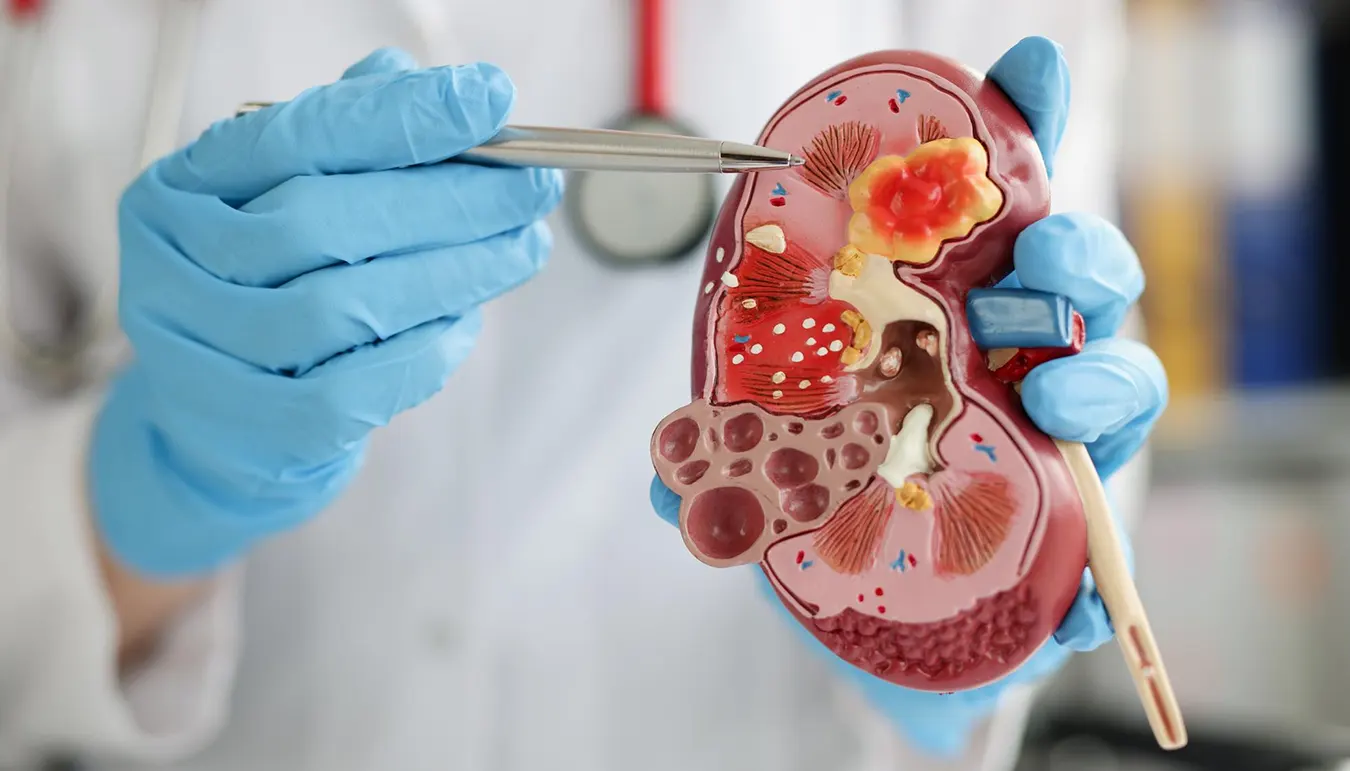Kidney stones, a prevalent urological condition affecting millions worldwide, can inflict excruciating pain and significantly disrupt one's life. In this comprehensive guide, we embark on an in-depth exploration of kidney stones, unraveling their definition, symptoms, etiological factors, various types, prevention strategies, dietary recommendations, diagnostic methodologies, surgical interventions, and the latest cutting-edge technologies transforming their treatment landscape. By the conclusion of this extensive article, you will possess a profound understanding of kidney stones and how to effectively navigate their challenges.
What Is a Kidney Stone?
Kidney stones, scientifically termed nephrolithiasis or renal calculi, manifest as solid, crystalline structures that form within the kidney's intricate labyrinthine channels. These stones exhibit a wide spectrum of sizes, ranging from minuscule grains of sand to formidable golf ball-sized obstructions. They primarily consist of mineral and salt compounds that aggregate and adhere together, frequently causing discomfort and pain as they traverse through the urinary tract.
What Are the Symptoms of Kidney Stones?
The symptomatic presentation of kidney stones is characterized by an array of distressing sensations, including:
- Excruciating Pain: A defining hallmark of kidney stone affliction is the presence of intense pain, often likened to a piercing or throbbing sensation. This agonizing discomfort predominantly radiates from the lower back or flank region and extends toward the lower abdomen and groin.
- Frequent Urination: The onset of kidney stones often prompts an overwhelming urge for frequent urination, marked by urgency and persistence.
- Hematuria: A common indicator is the presence of blood in the urine, which can manifest as pink, red, or brown discoloration.
- Nausea and Vomiting: Intolerable pain and discomfort may trigger bouts of nausea and vomiting in afflicted individuals.
- Cloudy or Foul-Smelling Urine: Kidney stones can lead to urine that appears turbid or carries an unpleasant odor due to their presence.
- Urinary Tract Infections (UTIs): Kidney stones elevate the susceptibility to UTIs, potentially causing additional symptoms such as fever and chills.
What Are the Causes of Kidney Stones?
Kidney stones precipitate when substances in the urine accumulate in high concentrations, fostering the formation of crystalline structures. Numerous contributory factors underlie their genesis:
- Dehydration: Inadequate fluid intake culminates in concentrated urine, rendering it a conducive environment for the crystallization of minerals.
- Dietary Influences: A diet rich in oxalate-laden foods, excessive sodium consumption, and an overabundance of animal protein can heighten the vulnerability to stone development.
- Genetic Predisposition: A familial history of kidney stones can impart an inherent susceptibility to the condition.
- Underlying Medical Conditions: Conditions such as hyperparathyroidism and urinary tract infections can exacerbate the propensity for stone formation.
- Obesity: Excess body weight, particularly obesity, amplifies the likelihood of kidney stone emergence.
What Are the Types of Kidney Stones?
The categorization of kidney stones extends across several distinct types, each distinguished by its composition:
- Calcium Oxalate Stones: Preeminent among kidney stone varieties, these form when calcium combines with oxalate in the urine.
- Struvite Stones: Frequently linked with urinary tract infections, these stones comprise magnesium, ammonium, and phosphate compounds.
- Uric Acid Stones: Emanating from an excess of uric acid in the urine, these stones are prevalent among individuals afflicted by gout or those who indulge in high-purine diets.
- Cystine Stones: Rare yet genetically predisposed, these stones materialize due to an overabundance of cystine in the urine.
- Mixed Stones: On occasion, stones may exhibit a blend of minerals, necessitating specialized treatment strategies.
What Can Be Done to Prevent the Formation of Kidney Stones?
Proactive measures to forestall kidney stone occurrence encompass lifestyle modifications and dietary adjustments:
- Adequate Hydration: Maintain a robust habit of consuming copious quantities of water throughout the day to uphold urine dilution and mitigate the risk of crystalline formation.
- Dietary Modifications: Restrict the intake of high-oxalate foods, curtail sodium consumption, and exercise prudence in the consumption of animal proteins. Foster a well-balanced dietary regimen replete with fruits and vegetables.
- Management of Underlying Conditions: If concomitant medical conditions such as gout or hyperparathyroidism are present, ensure their diligent management to preclude stone formation.
- Pharmacological Interventions: In specific scenarios, healthcare practitioners may proffer medications aimed at averting the recurrence of kidney stones.
How Should People with Kidney Stones Eat?
The dietary approach for individuals grappling with kidney stones assumes pivotal significance:
- Hydration Emphasis: Imbibe a regimen that prioritizes hydration, with a recommended daily intake of 8-10 glasses of water to perpetuate adequate urine volume.
- Calcium Consideration: Contrary to conventional belief, calcium-rich foods should not be wholesale restricted unless explicitly advised by healthcare professionals.
- Oxalate Moderation: Exercise judicious restraint when consuming high-oxalate victuals such as spinach, beets, and chocolate.
- Sodium Reduction: Curtail salt intake to obviate calcium buildup within the urinary expanse.
- Fiber Inclusion: Embrace the inclusion of fiber-rich foods to foster digestive health and avert constipation.
What Foods Help Protect the Kidneys?
Certain foods can be enlisted as allies in the quest to fortify kidney health and thwart the formation of stones:
- Citrus Fruits: Lemons, limes, and oranges stand as paragons of virtue, being rich in citrate, a compound that impedes stone formation.
- Watermelon: Possessing a high water content, watermelon contributes to hydration and combats the risk of dehydration, a predisposing factor for stones.
- Berries: Blueberries, strawberries, and raspberries, being low in oxalate, can be judiciously incorporated into the diet.
- Leafy Greens: Kale, Swiss chard, and collard greens present as low-oxalate options that bolster a kidney-friendly nutritional regimen.
- Herbs and Spices: Parsley and basil harbor constituents that may exert a beneficial influence on kidney health.
How Are Kidney Stones Diagnosed?
A comprehensive diagnostic approach is instrumental in confirming the presence and attributes of kidney stones:
- Medical History: The initial phase often involves an exhaustive inquiry into the patient's symptoms, medical history, and any familial precedent of kidney stones.
- Physical Examination: A meticulous physical examination may unveil signs of discomfort, tenderness, or localized pain in the abdominal or back regions.
- Imaging Modalities: Diagnostic imaging, including X-rays, computed tomography (CT) scans, or ultrasounds, plays an integral role in visualizing the stones and ascertaining their precise location.
- Urine Analysis: Urinalysis serves as a valuable diagnostic tool, enabling the detection of hematuria (blood in the urine), crystal presence, and potential infection.
When Is Surgery Necessary for Kidney Stones?
Surgical intervention becomes imperative under the following circumstances:
- Large Stones: Stones surpassing the dimensions of 0.5 inches (1.27 cm) are less likely to spontaneously traverse the urinary tract.
- Obstruction: When a stone engenders urine flow obstruction or induces severe, debilitating pain, surgical intervention assumes a critical role in alleviating distress.
- Infection Association: Kidney stones accompanied by urinary tract infections warrant prompt removal or intervention.
- Lack of Spontaneous Passage: If a stone fails to navigate the urinary tract within a reasonable time frame, healthcare providers may advocate for surgical measures to avert complications.
How Are Kidney Stones Treated?
The approach to kidney stone management hinges on factors such as size, location, and type. Common therapeutic strategies encompass:
- Watchful Waiting: For petite stones, a watchful waiting approach may be adopted, facilitated by pain management and augmented fluid intake to expedite spontaneous passage.
- Medications: Healthcare practitioners may prescribe medications to mitigate pain, relax the urinary tract, or dissolve certain types of stones.
- Extracorporeal Shock Wave Lithotripsy (ESWL): This non-invasive procedure employs shock waves to fragment stones into smaller, more passable fragments.
- Ureteroscopy: Employing a thin, flexible scope, this procedure facilitates the removal or fragmentation of stones residing within the urinary tract.
- Percutaneous Nephrolithotomy (PCNL): For formidable or intricate stones, minimally invasive surgical procedures such as PCNL may be the preferred recourse.
New Technologies in the Treatment of Kidney Stones
The realm of kidney stone treatment has borne witness to remarkable advancements in medical technology, ushering in innovative approaches and techniques:
- Laser Lithotripsy: Laser technology assumes a pivotal role in precision-focused stone targeting and fragmentation, minimizing collateral tissue damage.
- Miniaturized Surgical Instruments: The advent of smaller and more advanced surgical instruments has ushered in a new era of minimally invasive procedures, characterized by swifter recovery times.
- Robot-Assisted Surgery: Robotic systems have empowered surgeons with enhanced precision and control in complex procedures, affording superior surgical outcomes.
- High-Resolution Imaging: Advanced imaging modalities have revolutionized the diagnostic and treatment landscape, offering greater accuracy in discerning stone composition and location.
Kidney stones, though painful and disruptive, are a challenge that can be effectively navigated with knowledge of their causes, symptoms, prevention strategies, and treatment options. Maintaining adequate hydration, adopting a kidney-friendly diet, and seeking guidance from healthcare professionals are pivotal steps in managing and preventing their recurrence. With the ongoing advancements in medical technology, the horizon looks promising for individuals contending with kidney stones, offering less invasive, more effective, and tailored treatment options to alleviate their suffering and enhance their quality of life.

 Türkçe
Türkçe
 English
English


